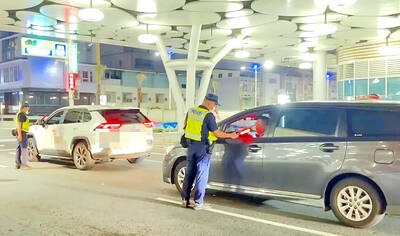The Ministry of Education’s first public hearing on a controversial draft of high school history curriculum guidelines ended yesterday amid debates over whether Taiwan’s history should be traced back to ancient Chinese history.
During the hearing held at Taipei Municipal Zhongshan Girls High School, pro-independence groups protested the ministry’s draft to merge ancient Taiwanese history with that of ancient Chinese.
Li Chuan-hsin (李川信), president of the Northern Taiwan Society, said Taiwan has never belonged to China and alleged that the Chinese Nationalist Party (KMT) government sought to amend the nation’s high school history curriculum guidelines for political reasons.
Li, who is also a teacher, said he used to teach his students that “we are Chinese.”
“But how many people in Taiwan nowadays truly think of themselves as Chinese?” Li asked.
However, Chi Hsing (紀欣), chairwoman of the Alliance for the Reunification of China, urged the ministry to clearly state in the guidelines that Taiwan has been part of China since the Dutch were driven out by Zheng Chenggong (鄭成?
Yesterday’s hearing was one of the four sessions organized by the ministry to address concerns raised by opposition lawmakers and academics about the draft publicized by the ministry on Monday.
In accordance with the draft, the ministry plans to have high school students spend one semester on Taiwanese history, one-and-a-half semesters on Chinese history and one-and-a-half semesters on world history in their first and second years.
Currently, high school students spend one semester on Taiwanese history, another semester on Chinese history and two semesters on world history.
Students majoring in liberal arts are required to take history on special topics in their senior year, but students majoring in science are not.
The ministry also plans to trace Taiwanese history back to China’s Three Kingdoms period (三國時代), which began in the year 220, a move interpreted by some Taiwanese academics as merging Taiwan’s history with China’s.
Max Huang (黃克武), director of the Academia Sinica’s Institute of Modern History and head of the ministry’s taskforce to amend the guidelines, said the taskforce understands that tracing Taiwanese history to ancient Chinese history would be controversial, adding that the ministry also plans to add footnotes to history textbooks telling students that there are different interpretations about this part of the history.
National Chengchi University history professor Hsueh Hua-yuan (薛化元) suggested that Southeast Asia be included in the guidelines given the close ties between Taiwan and the region.
Sung Wen-huei (宋文惠), a high school teacher, expressed similar views, saying that many Taiwanese children whose parents are from Southeast Asia should have the opportunity to learn the history of their parents’ homelands.

TRAFFIC SAFETY RULES: A positive result in a drug test would result in a two-year license suspension for the driver and vehicle, and a fine of up to NT$180,000 The Ministry of Transportation and Communications is to authorize police to conduct roadside saliva tests by the end of the year to deter people from driving while under the influence of narcotics, it said yesterday. The ministry last month unveiled a draft of amended regulations governing traffic safety rules and penalties, which included provisions empowering police to conduct mandatory saliva tests on drivers. While currently rules authorize police to use oral fluid testing kits for signs of drug use, they do not establish penalties for noncompliance or operating procedures for officers to follow, the ministry said. The proposed changes to the regulations require

The Executive Yuan yesterday announced that registration for a one-time universal NT$10,000 cash handout to help people in Taiwan survive US tariffs and inflation would start on Nov. 5, with payouts available as early as Nov. 12. Who is eligible for the handout? Registered Taiwanese nationals are eligible, including those born in Taiwan before April 30 next year with a birth certificate. Non-registered nationals with residence permits, foreign permanent residents and foreign spouses of Taiwanese citizens with residence permits also qualify for the handouts. For people who meet the eligibility requirements, but passed away between yesterday and April 30 next year, surviving family members

Taiwanese officials are courting podcasters and influencers aligned with US President Donald Trump as they grow more worried the US leader could undermine Taiwanese interests in talks with China, people familiar with the matter said. Trump has said Taiwan would likely be on the agenda when he is expected to meet Chinese President Xi Jinping (習近平) next week in a bid to resolve persistent trade tensions. China has asked the White House to officially declare it “opposes” Taiwanese independence, Bloomberg reported last month, a concession that would mark a major diplomatic win for Beijing. President William Lai (賴清德) and his top officials

The German city of Hamburg on Oct. 14 named a bridge “Kaohsiung-Brucke” after the Taiwanese city of Kaohsiung. The footbridge, formerly known as F566, is to the east of the Speicherstadt, the world’s largest warehouse district, and connects the Dar-es-Salaam-Platz to the Brooktorpromenade near the Port of Hamburg on the Elbe River. Timo Fischer, a Free Democratic Party member of the Hamburg-Mitte District Assembly, in May last year proposed the name change with support from members of the Social Democratic Party and the Christian Democratic Union. Kaohsiung and Hamburg in 1999 inked a sister city agreement, but despite more than a quarter-century of